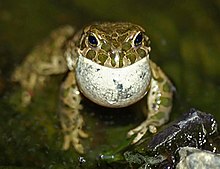
Bufo is a genus of true toads in the amphibian family Bufonidae. As traditionally defined, it was a wastebasket genus containing a large number of toads from much of the world but following taxonomic reviews most of these have been moved to other genera, leaving only seventeen extant species from Europe, northern Africa and Asia in this genus, including the well-known common toad. Some of the genera that contain species formerly placed in Bufo are Anaxyrus, Bufotes, Duttaphrynus, Epidalea and Rhinella.

The common toad, European toad, or in Anglophone parts of Europe, simply the toad, is a frog found throughout most of Europe, in the western part of North Asia, and in a small portion of Northwest Africa. It is one of a group of closely related animals that are descended from a common ancestral line of toads and which form a species complex. The toad is an inconspicuous animal as it usually lies hidden during the day. It becomes active at dusk and spends the night hunting for the invertebrates on which it feeds. It moves with a slow, ungainly walk or short jumps, and has greyish-brown skin covered with wart-like lumps.

The European green toad is a species of toad found in steppes, mountainous areas, semi-deserts, urban areas and other habitats in mainland Europe, ranging from far eastern France and Denmark to the Balkans and Western Russia. As historically defined, the species ranged east through the Middle East and Central Asia to western China, Mongolia and northwestern India, and south through Italy and the Mediterranean islands to North Africa. Following genetic and morphological reviews, 14 populations are now regarded as separate species. These species and the European green toad are placed in their own genus Bufotes, but they were included in Bufo.
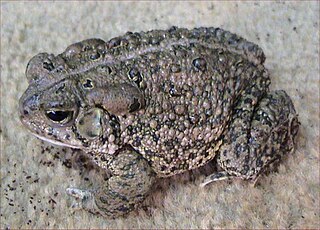
Woodhouse's toad is a medium-sized true toad native to the United States and Mexico. There are three recognized subspecies. A. woodhousii tends to hybridize with Anaxyrus americanus where their ranges overlap.
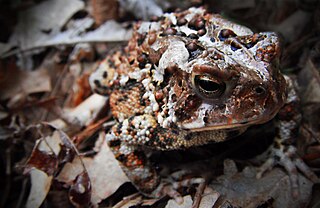
Fowler's toad is a species of toad in the family Bufonidae. The species is native to North America, where it occurs in much of the eastern United States and parts of adjacent Canada. It was previously considered a subspecies of Woodhouse's toad.

The North American green toad is a species of toad found in the southwestern United States in the states of Arizona, New Mexico, Colorado, Kansas, Oklahoma and Texas, as well as in northern Mexico in the states of Tamaulipas, San Luis Potosí, Durango, and Zacatecas. It is commonly called green toad.

The Great Plains toad is a relatively large species of true toad native to central North America.
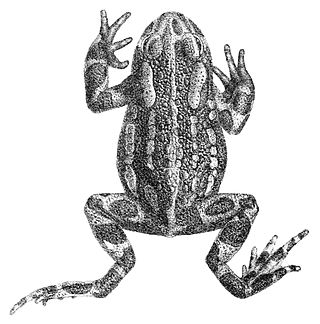
Pseudepidalea latastii is a species of toad found in the north-western Himalayas of India and Pakistan, where it lives between 2,600 and 3,000 metres.

The Mongolian toad, also known commonly as the piebald toad or the Siberian sand toad, is a species of toad in the family Bufonidae. The species is endemic to northeastern Asia. It was formerly placed in the genus Bufo, then for a few years in Pseudepidalea until finally moved to its own genus Strauchbufo.

Barbarophryne is a genus of toads in the family Bufonidae. It is monotypic, containing only the species Brongersma's toad, also known as Tiznit toad. It is found in Algeria and Morocco. It is a small toad, up to about 5 cm (2 in) in snout–to–vent length.

The Japanese common toad, Japanese warty toad or Japanese toad is a species of toad in the family Bufonidae. It is endemic to Japan. Its natural habitats are subarctic forests, temperate forests, temperate shrubland, swamps, freshwater marshes, intermittent freshwater marshes, freshwater springs, arable land, rural gardens, urban areas, ponds, and irrigated land. Amplexus is the mating behaviour involved in the Japanese common toad during the breeding season.
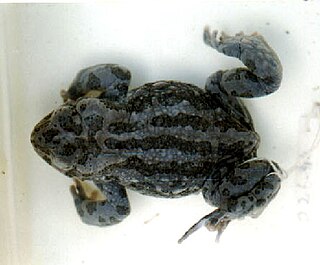
Bufotes latastii, commonly known as the Baltistan toad, Ladakh toad or vertebral-banded toad, is a species of toad in the family Bufonidae. It is found in the West Himalayan region at altitudes of 780–3,200 m (2,560–10,500 ft) from northern Pakistan to Ladakh in India; although sometimes reported elsewhere, this is the result of misidentifications of other species. It is found in alpine forests, coniferous forests, grasslands, paddy fields, mountain desert and roadsides. It often lives near water, like lakes and ponds, in the riparian growth. It can be beneficial to humans as it feeds on insects and their larvae within areas of agriculture.

Bufotes luristanicus, the Lorestan earless toad or Lorestan toad, is a species of toad in the family Bufonidae. It is endemic to the Zagros Mountains in Iran and occurs at an altitude of 350–1,300 m (1,150–4,270 ft), most often near rocky outcrops or freshwater ponds, which it also uses for breeding. Little is known about this species, but it is not considered threatened overall. Some local populations may be threatened by habitat loss from human activities or drought.

Bufotes pewzowi is a species of toad in the family Bufonidae. It is found in dry plains of Central Asia, the foothills and mountains of Tian Shan, Zhungar Alatau and Pamir Mountains, the mountains and deserts of Western China and Mongolia, and probably westward to northern Afghanistan and north to Lake Balkhash in Kazakhstan and northeast Altai Republic in Russia. The specific name pewzowi honours Michail Wassiljewitsch Pewzow, a Russian geographer, cartographer, and explorer. Common names include Xinjiang toad and Pewzow's toad; when subspecies B. p. strauchi is recognized, it can be referred to as northern Xinjiang toad, while the nominotypic B. p. pewzowi then becomes southern Xinjiang toad.
Bufotes pseudoraddei is a species of toad in the family Bufonidae. It is found in the West Himalayan region, including northern Pakistan and the border area between western Xizang of China and adjacent northwestern India. Its natural habitats are temperate forests, intermittent freshwater marshes, arable land, pastureland, plantations, and rural gardens.
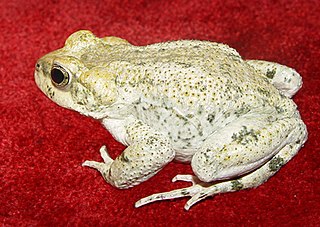
Bufotes surdus, also known as Iranian earless toad, Iranian toad, Pakistan toad, or Luristan toad, is a species of toad in the family Bufonidae. It is found in southern Iran and western Pakistan. There is also an isolated record from eastern Iraq.
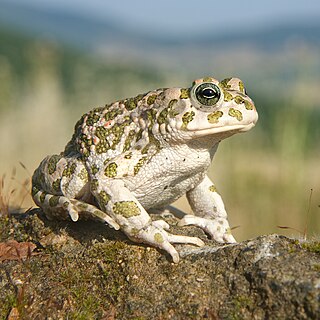
The Balearic green toad is a toad belonging to the true toad family, Bufonidae, from Italy and islands in the western Mediterranean Sea. It is mostly a lowland species, but can be found as high as 1,300 m (4,300 ft) asl in central Italy.

The African green toad is a species of toad found in North Africa from Morocco to Egypt, and on the Italian islands of Sicily, Favignana, Lampedusa and Ustica. The populations on the Italian islands were described as a separate species, the Sicilian green toad, in 2008, but more recent authorities treat it as a subspecies of the African green toad because they are very closely related. Both were historically included in the European green toad and all have been included in the genus Bufo. It was previously suggested that the African green toad might range east into Sinai and the Levant, but a review has shown that this involves the related B. sitibundus. The African green toad is found from coastal areas to highland plateaus in forests, scrubland, grassland, semi-deserts and deserts; it breeds in temporary ponds and similar habitats.


